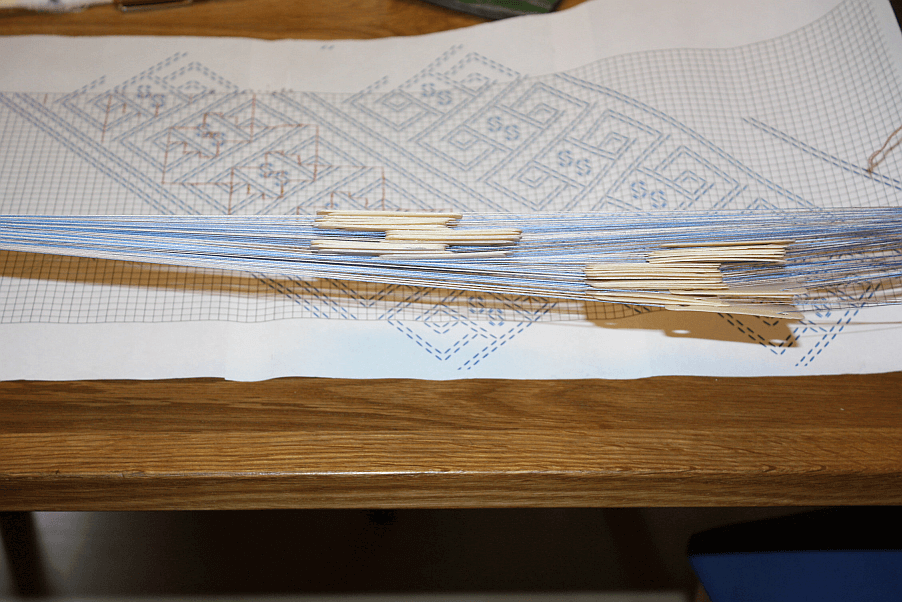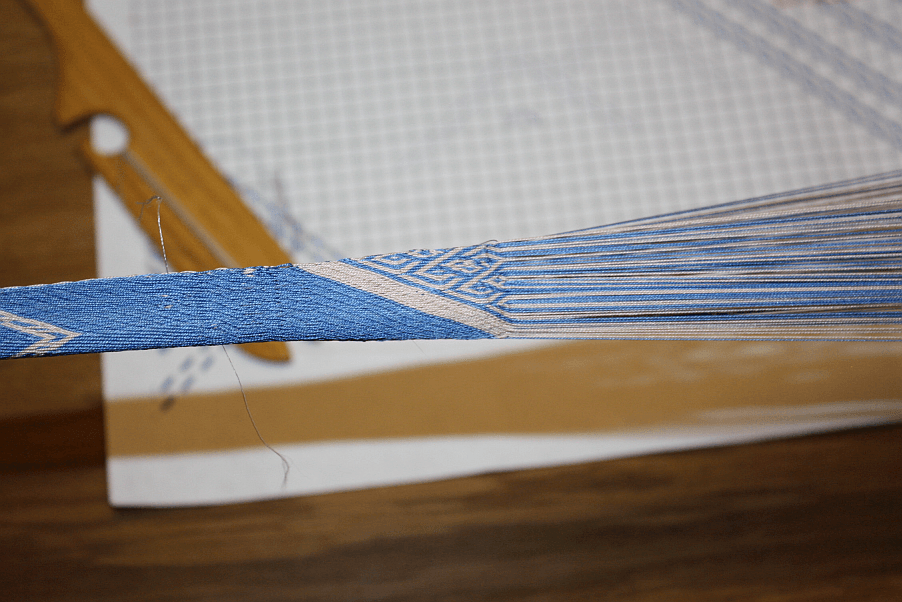Search the Blog
Latest Comments
Beatrix
Experiment!
23. April 2024
The video doesn´t work (at least for me). If I click on "activate" or the play-button it just disapp...
Katrin
Spinning Speed Ponderings, Part I.
15. April 2024
As far as I know, some fabrics do get washed before they are sold, and some might not be. But I can'...
Kareina
Spinning Speed Ponderings, Part I.
15. April 2024
I have seen you say few times that "no textile ever is finished before it's been wet and dried again...
Katrin
How on earth did they do it?
27. März 2024
Ah, that's good to know! I might have a look around just out of curiosity.
I've since learned that w...
Heather Athebyne
How on earth did they do it?
25. März 2024
...though not entirely easy. I've been able to get my hands on a few strands over the years for Geor...
Brainbenders!
I've been tablet weaving again, a bit, trying to wrap my brain around... stuff. I've used the next Textile Forum as an excuse for this, as I want to take a look at tablet weaving, or, more concisely, on how patterning was done.
This is one of the things that keep fascinating me, and that I've wondered about for ages. We have incredibly complex weave patterns (not only in tablet weaves, but that technique is more accessible to me than loom weaving), and when we do these patterns today, trying to recreate the historical textiles, it usually results in a huge chart for the weaving pattern. Heidi Stolte once took the pattern from the maniple of St. Ulrich, and the pattern drawing on graph paper is about 7 m long and a good 70 cm wide. That is huge.
For the tenth century, we can quite safely assume that there was no similar roll of graph paper with the pattern on it. Which means that the weaver was either just all making it up as he or she went along, or had something else to work with. What, though - something like a sampler band, a sketch, or a different kind of pattern, or just a memory aid such as a rhyme - we don't know.
Now, whatever the aid for the patterning, it will most probably require you to be able to look at the band and see what has to come next. There might also be a kind of flow to the pattern at some point... so since the Ulrich maniple has also been fascinating me for ages, I took a part of the pattern and a silk band with 42 tablets, sat down and tried my hand.

From my previous tablet weaving experience, I found that having strict rules on how things are done and in what sequence they are done does help a lot. The tablets are separated into packs that turn in different directions, and I know which direction of turn always results in which slant in the band. In this band with its 42 tablets, I have split them into two sections that I can still turn with good control; a necessity that, unfortunately, also complicates matters a little.

I have a few ideas on how this could work, and I've had a bit of success before in getting an inkling on how and where to look, but today, unfortunately, my brain was not up to it - partly because there was a mistake to fix, and then I wanted to get a few picks correctly, and so I sort of fell into the trap of going after the charted pattern, counting tablets and marking off picks that were done instead of looking at lines and structures... which, yes, is a brainbender, but much more helpful than counting 5-3-1-change next 2- and so on. I've not given up hope, though - there will be more time spent at the band.
Probably with more coffee. And some chocolate.
This is one of the things that keep fascinating me, and that I've wondered about for ages. We have incredibly complex weave patterns (not only in tablet weaves, but that technique is more accessible to me than loom weaving), and when we do these patterns today, trying to recreate the historical textiles, it usually results in a huge chart for the weaving pattern. Heidi Stolte once took the pattern from the maniple of St. Ulrich, and the pattern drawing on graph paper is about 7 m long and a good 70 cm wide. That is huge.
For the tenth century, we can quite safely assume that there was no similar roll of graph paper with the pattern on it. Which means that the weaver was either just all making it up as he or she went along, or had something else to work with. What, though - something like a sampler band, a sketch, or a different kind of pattern, or just a memory aid such as a rhyme - we don't know.
Now, whatever the aid for the patterning, it will most probably require you to be able to look at the band and see what has to come next. There might also be a kind of flow to the pattern at some point... so since the Ulrich maniple has also been fascinating me for ages, I took a part of the pattern and a silk band with 42 tablets, sat down and tried my hand.

From my previous tablet weaving experience, I found that having strict rules on how things are done and in what sequence they are done does help a lot. The tablets are separated into packs that turn in different directions, and I know which direction of turn always results in which slant in the band. In this band with its 42 tablets, I have split them into two sections that I can still turn with good control; a necessity that, unfortunately, also complicates matters a little.

I have a few ideas on how this could work, and I've had a bit of success before in getting an inkling on how and where to look, but today, unfortunately, my brain was not up to it - partly because there was a mistake to fix, and then I wanted to get a few picks correctly, and so I sort of fell into the trap of going after the charted pattern, counting tablets and marking off picks that were done instead of looking at lines and structures... which, yes, is a brainbender, but much more helpful than counting 5-3-1-change next 2- and so on. I've not given up hope, though - there will be more time spent at the band.
Probably with more coffee. And some chocolate.
Comments
No comments made yet. Be the first to submit a comment



